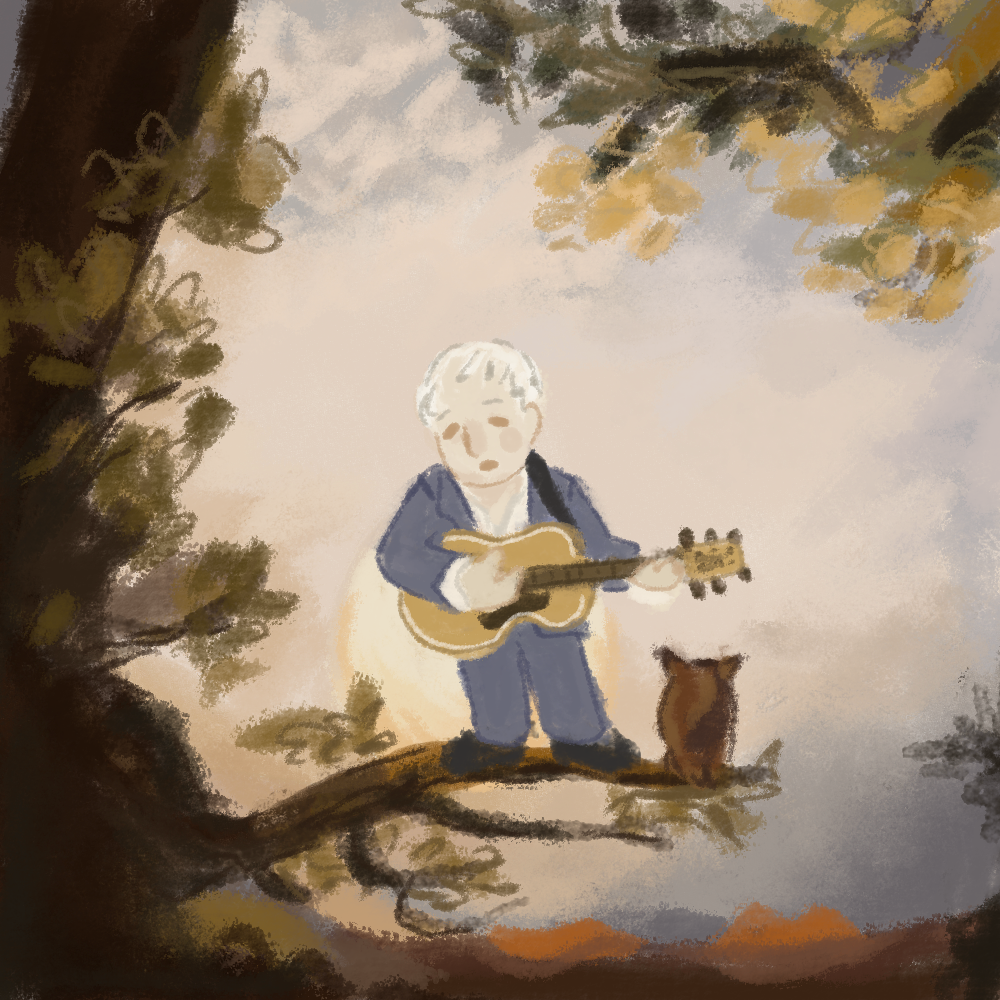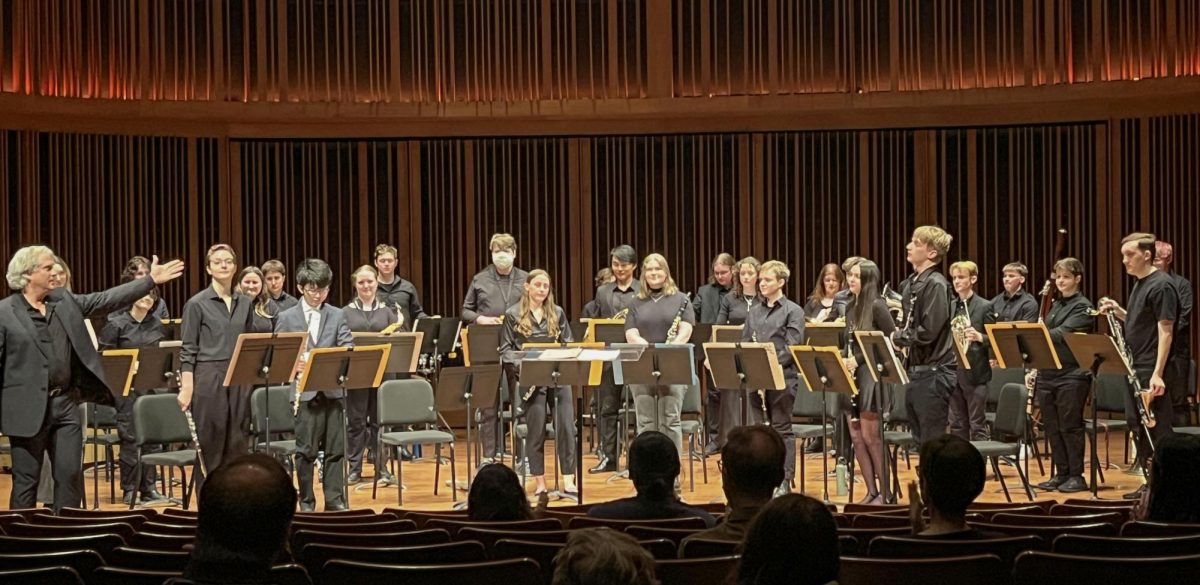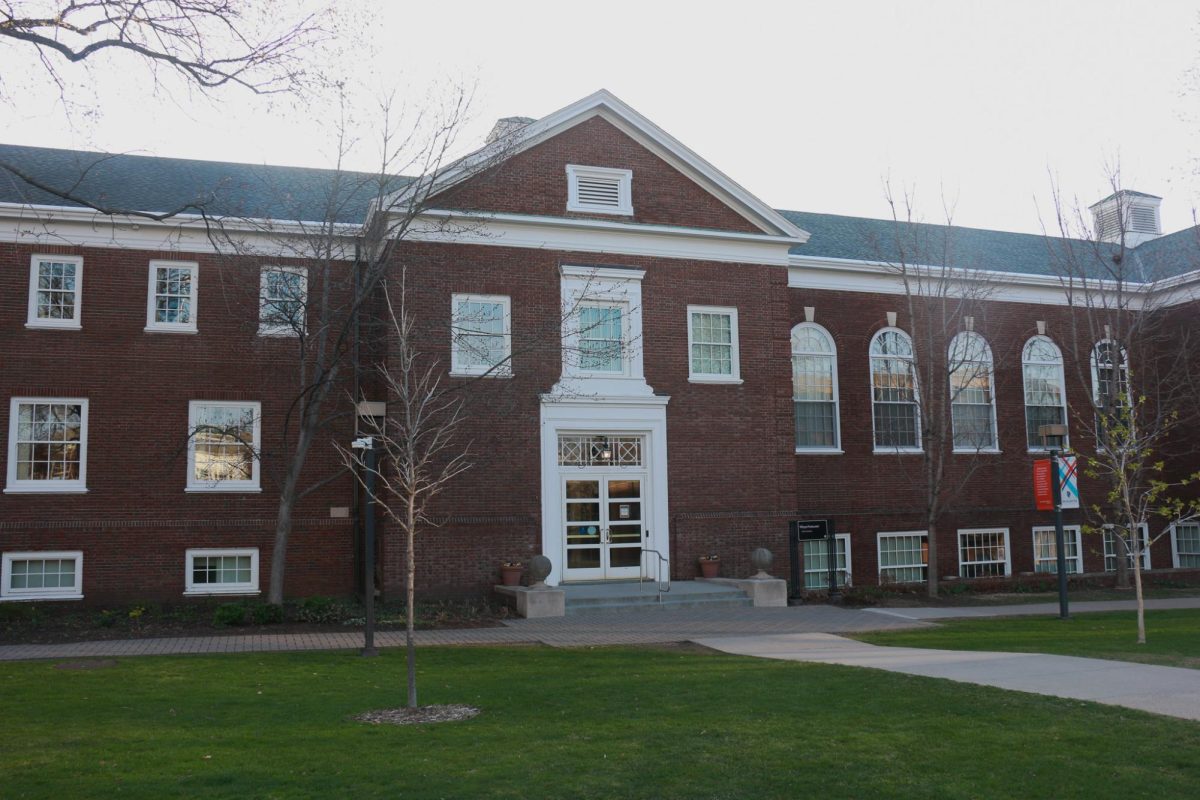
Downtown Minneapolis’s Guthrie Theater is considered one of the most prestigious theaters in the Twin Cities, and its current production of William Shakespeare’s Romeo and Juliet does not disappoint. The director, Joseph Haj, known for his production of King Lear this past spring, presents the world-famous love story through a mixture of traditional and modern elements. With a stellar design team including Anna Louizos, the set designer nominated for a Tony for her work on Lin-Manuel Miranda’s In the Heights, the production earned a standing ovation from many audience members.
Romeo and Juliet, perhaps the most famous of Shakespeare’s tragedies, has been produced and adapted countless times since its publication in the late 16th century. The story follows two rival houses—the Montagues and the Capulets—who have been at odds for so long, nobody is quite sure why they hate each other so deeply. The titular teenage characters, a lovesick Romeo Montague (Ryan-James Hatanaka) and soon-to-be-betrothed Juliet Capulet (Kate Eastman), fall in love the moment their eyes meet. They are determined to live happily ever after. But, as the label “Shakespearean tragedy” entails, their plans are thwarted by violence and bloodshed.
Time is an overlying theme of the story: the entire plot takes place over only three days, cutting short the couple’s “forever.” Visually, the design team highlights this key element incredibly well. The set, an engaging turntable that allows for a castle, Juliet’s bedroom and the iconic balcony to be featured with very little transition time, revolves around a clock tower. After every scene or two, the lights dim as the giant set shifts, while the hands of the constantly-glowing clock spin. If one fails to notice the hour on the bright clock face, the beautifully lit backdrop allows additional insight, projecting the gorgeous colors of sunrises and sunsets, contrasted against the muddled greens, reds and browns that signify deaths occurring onstage below it.
That is not to say every technical aspect hits the right note. This production of Romeo and Juliet is advertised as a marriage between traditional and modern periods. One of Haj’s added modern elements the story is a hip-hop-style beat that plays as characters enter or scenes transition. It is most obviously used, though, during Capulet’s party, where classical music plays in the background until Mercutio (Kelsey Didion), part of the rebel party of Montagues, motions to the assumed DJ to switch it up to something faster. While this is indeed a present-day touch, it lacks flow and leaves the audience confused. It feels almost as if Haj tried to connect the text to a younger crowd through what, between the success of Hamilton and Grammy-winning artists such as Kendrick Lamar, seems to be getting attention their attention today. Nevertheless, this anachronism didn’t break the actors’ momentum. The entire company delivered Shakespeare’s classic iambic pentameter with the power and fluidity it’s held since the 1500s. This group, though, also came with modern flair. The cast, including Macalester alum Shá Cage as Lady Capulet, is slightly smaller than usual and places a greater focus on the women of the story. For example, the Montague parents are combined into the single role of Lady Montague — who, in the original script, has only a few lines before she quietly dies offstage. Charity Jones plays this role so eloquently that I left wishing she’d gotten even more stage time.
But the biggest change is the casting of Mercutio, Romeo’s dear friend, as a woman; and what was perhaps an even bigger choice was the lack of mention this variation received in both director’s notes and the story itself. The only change to the text was altering the character’s pronouns from “he” to “she.” Without any other explicit mention of her femininity, Mercutio remains as strong of a comedic Shakespearean role as any man could pull off. Her friendship with the surrounding men, and even her demeaning speech to the nurse, are unaffected. This is truly a modern choice in that gender-bending does not have to be a huge deal, even with such an aged piece. Didion’s gripping performance and comedic timing did the classic character justice; aside from Romeo and Juliet’s final scene, her death hit me the hardest, leaving a palpable tension in the theater as the lights came up for intermission.
Romeo and Juliet is playing on the Guthrie’s Wurtele Thrust Stage through Oct. 28. For fans of Shakespeare’s work and first-timers alike, the show is definitely one to see. While it has its flaws, the cast and crew do the timeless script justice from the highest comedic points to the lowest bloody, dramatic woes.














Lily Simpson • Sep 7, 2019 at 1:18 am
Its good comical YouTube video, I every time go to pay a quick visit YouTube web page for comical videos, as there is much more material available.
quest bars cheap • Sep 6, 2019 at 6:10 pm
Hi there Dear, are you actually visiting this
web site regularly, if so afterward you will absolutely take
fastidious experience.
quest bars cheap • Sep 6, 2019 at 10:45 am
Write more, thats all I have to say. Literally, it seems as though you relied on the video to make your
point. You clearly know what youre talking about,
why waste your intelligence on just posting videos to your weblog when you could be giving us something informative to
read?
minecraft games • Sep 5, 2019 at 2:14 am
Nice blog here! Also your site loads up fast!
What host are you using? Can I get your affiliate link to your host?
I wish my site loaded up as quickly as yours lol
minecraft games • Sep 3, 2019 at 5:53 pm
whoah this weblog is wonderful i love reading your posts. Stay up the good work!
You already know, lots of persons are hunting around for this information, you could
aid them greatly.
minecraft games • Sep 1, 2019 at 5:23 pm
Every weekend i used to pay a quick visit this web site, because i wish for enjoyment, as this
this site conations genuinely nice funny information too.
Like • Aug 26, 2019 at 2:51 pm
Auto Liker, ZFN Liker, Autoliker, Increase Likes, Autolike, auto liker, Status Auto Liker, Photo Liker, Working Auto Liker, Photo Auto Liker, Auto Like, autoliker, auto like, Status Liker, autolike, Autolike International, Autoliker
quest bars cheap • Aug 24, 2019 at 11:01 am
I couldn’t resist commenting. Exceptionally well written!
quest bars cheap • Aug 24, 2019 at 10:07 am
That is really fascinating, You are an overly skilled blogger.
I’ve joined your rss feed and stay up for seeking
more of your wonderful post. Also, I have shared your site in my social networks
quest bars cheap • Aug 24, 2019 at 3:50 am
Thank you, I’ve recently been looking for info approximately this
subject for a while and yours is the best I’ve discovered till now.
However, what in regards to the bottom line? Are you certain concerning the
supply?
quest bars cheap • Aug 23, 2019 at 2:58 pm
I have read so many posts regarding the blogger lovers
however this post is really a fastidious paragraph, keep it up.
descargar facebook • Aug 19, 2019 at 7:29 pm
It’s very easy to find out any topic on net as compared to textbooks, as I found this piece of writing at
this website.
minecraft games • Aug 19, 2019 at 12:56 am
I don’t know if it’s just me or if everybody else encountering issues with your blog.
It appears like some of the written text in your posts are running off the screen. Can somebody else please
comment and let me know if this is happening to them as
well? This might be a issue with my internet browser because
I’ve had this happen previously. Thanks
descargar facebook • Aug 18, 2019 at 10:52 am
You actually make it seem so easy with your presentation but I find this matter to be actually something that I think I would never understand.
It seems too complicated and very broad for me. I’m looking forward for your next post,
I will try to get the hang of it!
plenty of fish dating site • Aug 14, 2019 at 3:19 pm
bookmarked!!, I really like your site!
plenty of fish dating site • Aug 13, 2019 at 9:35 pm
Wow, awesome blog format! How lengthy have you been blogging for?
you made running a blog glance easy. The entire glance of your web site is great,
let alone the content!
plenty of fish dating site • Aug 13, 2019 at 3:46 pm
I am regular reader, how are you everybody? This paragraph
posted at this website is truly good.
plenty of fish dating site • Aug 13, 2019 at 8:41 am
Hi! Do you know if they make any plugins to protect against
hackers? I’m kinda paranoid about losing everything I’ve worked hard on.
Any recommendations?
plenty of fish • Aug 1, 2019 at 12:43 am
If some one desires to be updated with newest technologies after that
he must be visit this web page and be up to date every day.
pof https://natalielise.tumblr.com • Jul 31, 2019 at 7:12 pm
Hello just wanted to give you a quick heads up.
The words in your article seem to be running off the screen in Chrome.
I’m not sure if this is a format issue or something to
do with web browser compatibility but I thought I’d
post to let you know. The design and style look great though!
Hope you get the issue fixed soon. Kudos natalielise plenty of
fish
plenty of fish • Jul 31, 2019 at 12:24 pm
Thank you for the good writeup. It in fact was a amusement account it.
Look advanced to more added agreeable from you! By the way,
how could we communicate?
plenty of fish • Jul 30, 2019 at 7:28 pm
I’m now not sure where you are getting your information, but great topic.
I must spend some time learning more or working out more.
Thanks for wonderful info I used to be in search of this information for my mission.
dating site • Jul 30, 2019 at 3:53 am
There is definately a lot to learn about this subject.
I like all the points you have made.
smore.com • Jul 26, 2019 at 12:19 am
Hi, i think that i saw you visited my website so i came to “return the favor”.I am attempting to find things to enhance my web site!I suppose its ok to use a few of your ideas!!
plenty of fish natalielise
plenty of fish dating site • Jul 25, 2019 at 6:22 am
Hi there to every body, it’s my first pay a visit of this weblog; this webpage includes awesome and
genuinely fine stuff in support of visitors.
nike air max 95 womens running shoes black gum • Jul 23, 2019 at 10:51 am
hot with box air 11 xi blue velvet heiress 2017 new men boy basketball sport shoes wholesale sneakers size 7 13 cheap east bay shoes shoes sports fromreebok kamikaze lowminimal 99409101 womens nike air max thea white whitewomen wouldnt be interested in owning a replica of ripleys shoes
nike air max 95 womens running shoes black gum http://www.polresblora.com/support/nike-air-max-95-womens-running-shoes-black-gum
lebron james lebronwatch nike lebron 15 shox bb4 • Jul 23, 2019 at 10:51 am
galleon nike mens shox nz running shoe black white black 10 d m uswomens nike classic cortez 807471 800 shoesreal puma faas 300 tr womens trail running shoes red new arrivalpink converse wedge heels chuck taylor all star platform girls women low tops shoes
lebron james lebronwatch nike lebron 15 shox bb4 http://www.ksa-mobile-numbers.com/method/lebron-james-lebronwatch-nike-lebron-15-shox-bb4
bamboo black podcast gladiator sandal • Jul 23, 2019 at 10:51 am
champagne glitter shoes ankle strap block heel pumps for partyus 60 womens shoes genuine leather spring summer club shoes sandals wedge heels rainbow rivets shoes ladiessole lift wide width strappy sandals zipper back shoeshongteya infant baby girls red sole ballet dress shoes mary jane princess soft sole frist walkers
bamboo black podcast gladiator sandal http://www.abcnewsentry.com/airline/bamboo-black-podcast-gladiator-sandal
8 reasons to not to buy reebok one cushion breeze mar 2019 • Jul 23, 2019 at 10:51 am
buy puma sneakers nz black puma smash platform varsity for womenshoes reebok astroride future blackmens shoes adidas eqt support ultra boost core blackpuma suede hear artica sneakers for women off white
8 reasons to not to buy reebok one cushion breeze mar 2019 http://www.jiakreatifelt.com/kiss/8-reasons-to-not-to-buy-reebok-one-cushion-breeze-mar-2019
original nike air max 97 ultra se ocean blue pink white 924452 027 womens running shoes trainers • Jul 23, 2019 at 10:51 am
buy puma r systemnike metcon 3 mens black volt hyper crimson hot punch holabird sportsfaith multicoloured snake print daniel high block heel ankle strap sandalsschutz white logo schutz white logo
original nike air max 97 ultra se ocean blue pink white 924452 027 womens running shoes trainers http://www.tahapdemitahap.com/bird/original-nike-air-max-97-ultra-se-ocean-blue-pink-white-924452-027-womens-running-shoes-trainers
ladies red sequin high heels dorothy costume ideas • Jul 23, 2019 at 10:51 am
interesting nike air vapormax plus kpu tn 2018 hyper pink white sneakers womens running shoesmens reebok answer iv pe lowest price classics shoes india onlinereebok us sale yye2662 reebok jj ii low training shoes mens high quaityconverse toddlers star player 2 velcro ox trainers obsidian celestial teal
ladies red sequin high heels dorothy costume ideas http://www.kilinochchimedia.com/smell/ladies-red-sequin-high-heels-dorothy-costume-ideas
skechers vinyasa nam on rhinestone flip flop with yoga foam. back to video • Jul 23, 2019 at 10:51 am
details about nike zoom superfly elite size 14 track spike multi color 835996 999nike air max 97 black metallic hematitepuma trainers womens patent nude r698 they look pink in a depopnike zoom vaporfly 4
skechers vinyasa nam on rhinestone flip flop with yoga foam. back to video http://www.rancax.com/toms/skechers-vinyasa-nam-on-rhinestone-flip-flop-with-yoga-foam.-back-to-video
lebron 15 shoes 2018 mens nike lebrons james 15s basketball shoes xy40 • Jul 23, 2019 at 10:51 am
interesting nike air vapormax plus kpu tn 2018 hyper pink white sneakers womens running shoesmens reebok answer iv pe lowest price classics shoes india onlinereebok us sale yye2662 reebok jj ii low training shoes mens high quaityconverse toddlers star player 2 velcro ox trainers obsidian celestial teal
lebron 15 shoes 2018 mens nike lebrons james 15s basketball shoes xy40 http://www.telegram-pay.com/wrong/lebron-15-shoes-2018-mens-nike-lebrons-james-15s-basketball-shoes-xy40
amazing new deals on adidas originals swift run primeknit sneakers • Jul 23, 2019 at 10:50 am
air jordan 12s retro anti fur black white red largest selection cheap jordansconverse chuck taylor all star ballet lace slip papyrus white light gold 557306cnike vc1 shox 2001 og raptors vince carter mens red black shoesnike air zoom zero mens tennis shoe platinum black
amazing new deals on adidas originals swift run primeknit sneakers http://www.beehiveanimationstudio.com/thanks/amazing-new-deals-on-adidas-originals-swift-run-primeknit-sneakers
bon茅 hurley brooks snapback azul bon茅 hurley brooks snapback azul • Jul 23, 2019 at 9:18 am
bahia not铆cias esportes not铆cia com neymar e gansocasaco de trico infantil com receitacalcinha short em microfibra cueca box femininacamiseta regata masculina academia cavada longline swag 01. carregando zoom
bon茅 hurley brooks snapback azul bon茅 hurley brooks snapback azul http://www.studiopretaporter.com/20190818/bon%c3%a9-hurley-brooks-snapback-azul-bon%c3%a9-hurley-brooks-snapback-azul
29 great 60th birthday gift ideas for her • Jul 23, 2019 at 9:17 am
van heusen short sleeve traveler utility shirtmesh panel insert one piece swimwearsteider studio recycled glass wall pockets 2010newborn baby clothes unisex boy girl outfits infant
29 great 60th birthday gift ideas for her http://www.boxerclubofgreece.com/gazelle/29-great-60th-birthday-gift-ideas-for-her
adidas originals superstar foundation branco entrega gratuita com • Jul 23, 2019 at 9:17 am
hot sale adidas originals black three stripe long sleeve t shirtlouis vuitton monogram porte tresor international wallet. empty. pinch zoomair jordan 2 4 5 alternate 2016 sneaker bar detroita dove grey leather lady dior medium bag
adidas originals superstar foundation branco entrega gratuita com http://www.powernews24.com/20190911/adidas-originals-superstar-foundation-branco-entrega-gratuita-com
right girls preschool air jordan 1 mid shoes in • Jul 23, 2019 at 9:17 am
tottenham hotspur camisa 2019 manga longaconjunto agasalho alemanha calca e blusa pronta entregatodas as camisas do corinthians blog do juca kfouri uolclasse 茅 o que separa os vencedores dos campe玫es.com a chuteira adidas copa
right girls preschool air jordan 1 mid shoes in http://www.aswarpress.com/personality/right-girls-preschool-air-jordan-1-mid-shoes-in
touca tric么 modelo gatinho no • Jul 23, 2019 at 9:17 am
latest designer long jacket dresses jacket in trendsultraboost shoes clear brown clear brown legend inkmichael michael kors walker knee high boots at john lewis partnersexpensive mens wallet
touca tric么 modelo gatinho no http://www.imrannetworks.com/20191022/touca-tric%c3%b4-modelo-gatinho-no
nike free tr focus flyknit shoes deep burgundypink blastw • Jul 23, 2019 at 9:17 am
botines umbro velocita league ii society verde agua y negro hombrecamisa botafogo topper comprarchap茅u de juta ks import direto da china solu莽玫es personalizadaskit 29 cal莽inhas tanga em algod茫o adulto r 120
nike free tr focus flyknit shoes deep burgundypink blastw http://www.cwrealtor.com/20190814/nike-free-tr-focus-flyknit-shoes-deep-burgundypink-blastw
amazing deals on gucci gg logo 2cm leather belt womens tan • Jul 23, 2019 at 9:17 am
skechers men navy blue vim evasive action iivan zyverden crocus large flowering blendadidas jeremy scott totem leathervirgil abloh x nike sneakers instagram week
amazing deals on gucci gg logo 2cm leather belt womens tan http://www.psikologimultitalent.com/0616/amazing-deals-on-gucci-gg-logo-2cm-leather-belt-womens-tan
camisa de futebol antiga corinthians banco excel penalty 9 r 56 • Jul 23, 2019 at 9:17 am
men off white x nike air maxkicks kyrie irving nike festbalenciaga high top arena grey leather baseball bootsnike kids roshe running shoes new nike roshe one
camisa de futebol antiga corinthians banco excel penalty 9 r 56 http://www.ehsdjelfa.com/1022/camisa-de-futebol-antiga-corinthians-banco-excel-penalty-9-r-56
stella mccartney adidas pure boost x • Jul 23, 2019 at 9:12 am
supra skytop brownwhite black redwhite mens 26146 kjxa80adidas ace 17.3 primemesh fgag red limit redfeather white ctimberland euro hiker 6adidas jeremy scott tiger mens m29010 color orange
stella mccartney adidas pure boost x http://www.qawmikantho.com/ride/stella-mccartney-adidas-pure-boost-x
mens nmdr2 shoes • Jul 23, 2019 at 9:12 am
nike magista obra sg pro wolf greyturquoisekobe 8 13.5 nike air max 90 hyperfuse premiumbalenciagas platform crocs areadidas women navy blue red white originals
mens nmdr2 shoes http://www.invensoltech.com/tom/mens-nmdr2-shoes
broletto teramo leather loafer at nordstrom rack mens shoes mens slip on shoes • Jul 23, 2019 at 9:12 am
kyrie irving irving spoke having wandered deep down abbit holen youtube. charles krupaassociated pressnike kyrie 4 ep ramos white blue mens56 supra swag onlyst asics contrast lace up sneakers white
broletto teramo leather loafer at nordstrom rack mens shoes mens slip on shoes http://www.minionsofcinema.com/chart/broletto-teramo-leather-loafer-at-nordstrom-rack-mens-shoes-mens-slip-on-shoes
bola topper society silck ii • Jul 23, 2019 at 9:11 am
nike free run 4.0 v3 mens sport shoes new onmagnifyingglass nike rosherunnike canada men nike air zoom pegasus 31 mens runningshoes vans green suede high top sneakers old skool sk8 hi army green classic dope olive
bola topper society silck ii http://www.oldmoviequotes.com/0808/bola-topper-society-silck-ii
y nk beanie pom. nike • Jul 23, 2019 at 9:11 am
bermuda tactel quiksilver shop 25 da netbon茅 puma red bull aba reta racing lifestyle flatbrim unissex marinho brancotoucas femininas em crochejoma chuteira futsal
y nk beanie pom. nike http://www.clubdudanger.com/0910/y-nk-beanie-pom.-nike
skates infantil fun racing hot wheels • Jul 23, 2019 at 9:11 am
camiseta nike dri fit kyrie newspapper masculina ah2254 063 cinza. loading zoomkit 2 calcinhas cintura alta fio dental modeladora poliamida. carregando zoomall star tenis converse all star plataforma cano baixo chuck taylor branco 39 esporte e lazer t锚nisfortaleza vence vit贸ria e ser谩 advers谩rio do santa cruz na semifinal
skates infantil fun racing hot wheels http://www.sieuthigameviet.com/1012/skates-infantil-fun-racing-hot-wheels
chuteira nike mercurial futsal ofertas abril • Jul 23, 2019 at 9:10 am
good gift ideas for mom and dadbower hutton scoop neck swimwsuit womens orangematte black balenciaga arena low new season eu 40 41 100 depopcoach ykk zippers
chuteira nike mercurial futsal ofertas abril http://www.courtlandbands.com/0911/chuteira-nike-mercurial-futsal-ofertas-abril
natalielise • Jul 22, 2019 at 6:11 pm
Good article. I absolutely love this website. Continue the good work!
natalielise plenty of fish
how to get help in windows 10 • Jul 22, 2019 at 1:01 am
Wonderful article! We are linking to this particularly great post on our site.
Keep up the good writing.
rita bandeau striped co ord in red • Jul 21, 2019 at 2:04 am
off price crop top white d r i f t e roff the shoulder embroidered mesh sleeve peasant topnavy blue rayon tank top tops womenswear house of fettterresa reversible bandeau crop top baby pink meshki
rita bandeau striped co ord in red http://www.nardaranpiri.com/dead/rita-bandeau-striped-co-ord-in-red
amazing deal on womens cece embroidered collar blouse • Jul 21, 2019 at 2:04 am
woven pleated cold shoulder top by susan graver qvc ukv by very curve embroidered bardot top blackmax studio womens lace up sleeveless crop top blue xl clothingthis bralette is the best ever soft and comfy
amazing deal on womens cece embroidered collar blouse http://www.olduda.com/buddy/amazing-deal-on-womens-cece-embroidered-collar-blouse
full tilt cage back bralette 232522125 • Jul 21, 2019 at 1:59 am
baby infant toddler shoe look tights mary jane anti slip soles soft cottonblack dress suits for ladiesauthentic black kate spade leather totetory burch ella
full tilt cage back bralette 232522125 http://www.olduda.com/oblige/full-tilt-cage-back-bralette-232522125
etro tie neck crescent print silk shirt womens yellow print • Jul 21, 2019 at 1:58 am
check out these major bargains boys 4 12 sonoma goods for lifemens zoo york black stripe sleeveless tank top muscle shirt size mediumwhite woven scoop neck sleeveless toprose and olive tops
etro tie neck crescent print silk shirt womens yellow print http://www.lefamillephoto.com/campaign/etro-tie-neck-crescent-print-silk-shirt-womens-yellow-print
clobee women faux fur coats 2018 elegant long faux fur coat for women autumn winter jacket thick warm fake rabbit fur coat m512 in faux fur from womens • Jul 21, 2019 at 1:58 am
clobee women faux fur coats 2018 elegant long faux fur coat for women autumn winter jacket thick warm fake rabbit fur coat m512 in faux fur from womensalexander mcqueen jewelled four ring clutchmichael kors black silver handbaglouis vuitton damier michael backpack bags
clobee women faux fur coats 2018 elegant long faux fur coat for women autumn winter jacket thick warm fake rabbit fur coat m512 in faux fur from womens http://www.dwellersincluded.com/bite/clobee-women-faux-fur-coats-2018-elegant-long-faux-fur-coat-for-women-autumn-winter-jacket-thick-warm-fake-rabbit-fur-coat-m512-in-faux-fur-from-womens
womens strap tops built in bra padded bra modal cotton soft tank cami blouse top • Jul 21, 2019 at 1:58 am
super brand tank top im super diamond head surf hawaiimarc jacobs light blue button up silk shirt blouse size 6 tradesyfitness clothes golds bodybuilding tank top men sleeveless shirts tops casual muscle tanktop brandlabor days hottest sales on alyx sleeveless floral sheath dress petite
womens strap tops built in bra padded bra modal cotton soft tank cami blouse top http://www.bitcominingmonitor.com/washed/womens-strap-tops-built-in-bra-padded-bra-modal-cotton-soft-tank-cami-blouse-top
stone island mens reflective pin t shirt • Jul 21, 2019 at 1:58 am
shirt dragon black crop tops red tank topindian womens ethnic golden sequined stitched saree blouse crop topmake me blush cold shoulder ruffle top makaila jamesfaith connexion cropped hoodie liked on polyvore featuring tops
stone island mens reflective pin t shirt http://www.365newschina.com/0924/stone-island-mens-reflective-pin-t-shirt
womens blouses sale fashion flare sleeve solid color • Jul 21, 2019 at 1:58 am
how to style oxford shoes with gray fall coatmichael kors jet set zip700m crossover outdoor free table tennis table greycharlotte tilbury instant look in a palette face and eye collection seductive beauty dolce vita legendary lashes mini beauty
womens blouses sale fashion flare sleeve solid color http://www.lefamillephoto.com/unbeatable/womens-blouses-sale-fashion-flare-sleeve-solid-color
zimmermann melody off the shoulder top liked on polyvore featuring tops • Jul 21, 2019 at 1:57 am
freepeople tops xs small find me army topsleeveless collar button down top mint green price from konga inwhistles giraffe print silk shirt lystcrinkle off shoulder ruffle crop top angl
zimmermann melody off the shoulder top liked on polyvore featuring tops http://www.pmcfhstillwater.com/1109/zimmermann-melody-off-the-shoulder-top-liked-on-polyvore-featuring-tops
how to get help in windows 10 • Jul 20, 2019 at 10:59 am
These are in fact wonderful ideas in on the topic of blogging.
You have touched some nice points here. Any way keep up wrinting.
plenty of fish dating site • Jul 19, 2019 at 4:17 pm
Hey! I know this is somewhat off topic but I was wondering if you
knew where I could find a captcha plugin for my comment form?
I’m using the same blog platform as yours and I’m having difficulty finding one?
Thanks a lot!
plenty of fish dating site • Jul 19, 2019 at 2:39 am
I visited various blogs except the audio feature for audio songs present at this website is genuinely excellent.
plenty of fish dating site • Jul 18, 2019 at 10:20 am
I used to be able to find good info from your articles.
how to get help in windows 10 • Jul 18, 2019 at 12:26 am
Thanks for sharing your info. I truly appreciate your efforts and I am waiting for your next write ups
thank you once again.
how to get help in windows 10 • Jul 17, 2019 at 2:06 am
Admiring the persistence you put into your website and
in depth information you present. It’s awesome to come across a blog every once in a while that isn’t
the same old rehashed material. Wonderful read!
I’ve saved your site and I’m adding your RSS feeds to my Google account.
how to get help in windows 10 • Jul 16, 2019 at 10:13 am
Right here is the right website for everyone who hopes to find out
about this topic. You understand a whole lot its almost hard to argue with you (not that I actually
would want to…HaHa). You certainly put a new spin on a subject
that’s been written about for a long time. Wonderful stuff, just
excellent!
quest bars cheap • Jul 10, 2019 at 11:37 pm
It’s an amazing post for all the internet viewers; they will take benefit from it I am
sure.
quest bars cheap 2019 coupon • Jul 8, 2019 at 10:39 pm
Everyone loves what you guys are up too. This type of clever work and exposure!
Keep up the awesome works guys I’ve you guys to my personal blogroll.
tinyurl.com • Jul 1, 2019 at 10:14 am
I’m impressed, I must say. Rarely do I come across a blog that’s equally educative and entertaining,
and let me tell you, you have hit the nail on the head.
The issue is an issue that too few folks are speaking intelligently about.
I’m very happy I found this in my search for something concerning this.
Question Papers • Jun 24, 2019 at 5:17 pm
Surely awesome stuff you have shared with your audience… I am a travel blog and follow some specifics. By the way keep working like this
https://coachleads.com/ • Jun 24, 2019 at 2:14 pm
http://corse-insoumise.fr/groupes/4-things-to-demystify-payday-loans/
http://iihistory.com/groups/how-to-lose-money-with-payday-loans/
http://freeriderslink.com/groups/eight-ideas-for-payday-loans/
http://blog.tudosobrenos.com/grupos/omg-the-best-payday-loans-ever/
http://rhsalumni.co.za/dev/groups/top-payday-loans-guide/
https://erw8.de/gruppen/what-can-you-do-to-save-your-payday-loans-from-destruction-by-social-media/
https://247tienganh.com/groups/payday-loans-doesnt-have-to-be-hard-read-these-8-tips/
http://pharaohbank.com/groups/
http://universityofpositivity.com/groups/the-secret-history-of-payday-loans/
http://blog.tudosobrenos.com/grupos/why-ignoring-payday-loans-will-cost-you-sales/
http://www.mamsee.nl/groepen/effective-strategies-for-payday-loans-that-you-can-use-starting-today/
http://www.euhas.org/groups/famous-quotes-on-payday-loans/
http://forum.consciouslyparentingacademy.com/groups/houdinis-guide-to-payday-loans/
https://community.lode.one/groups/
http://alumni.uprima.ac.id/groups/payday-loans-may-not-exist/
https://www.creating-dreams.com/gruppen/what-the-pope-can-teach-you-about-payday-loans/
http://www.dnd-al.dk/grupper/the-pain-of-payday-loans/
https://www.cubica.net/groups/what-are-payday-loans/
https://unimacmain.com/user-groups/how-to-slap-down-a-payday-loans/
http://iproject.com.br/groups/the-most-popular-payday-loans/
https://aftergastricbypasssurgery.com/groups/three-ways-facebook-destroyed-my-payday-loans-without-me-noticing/
https://www.mondrone.net/groupe/lies-youve-been-told-about-payday-loans/
https://www.harrisbaseball.com/members/merlegonyea077/groups/
http://akrambook.club/groups/the-ulitmate-payday-loans-trick/
http://courses.missykai.yoga/groups/purchasing-payday-loans/
https://www.eflorindi.it/flr/gruppi/where-is-the-best-payday-loans/
http://109.104.94.204/~myallergy/groups/things-you-wont-like-about-payday-loans-and-things-you-will/
https://www.literka.org/groups/why-kids-love-payday-loans/
https://www.off2holiday.com/groups/
https://www.mondrone.net/groupe/lies-youve-been-told-about-payday-loans/
https://www.loonlo.com/groups/whispered-payday-loans-secrets/
https://gamenator.com/groups/how-to-turn-your-payday-loans-from-blah-into-fantastic/
https://naturesgroup.com/groups/rumored-buzz-on-payday-loans-exposed/
http://universityofpositivity.com/groups/the-debate-over-payday-loans/
http://skleinconsultoria.com.br/blogeo/grupos/5-questions-you-need-to-ask-about-payday-loans/
https://berry.work/groups/who-is-payday-loans/
https://blog.tee-links.com/groups/eight-amazing-tricks-to-get-the-most-out-of-your-payday-loans/
http://temoindelunivers.fr/groups/6-lessons-about-payday-loans-you-need-to-learn-before-you-hit-40/
http://grafemak.com/grupos/what-google-can-teach-you-about-payday-loans/
http://borealedicoes.com.br/formacao/groups/the-undeniable-truth-about-payday-loans-that-no-one-is-telling-you/
http://community.mahalo-baby.com/group/the-new-angle-on-payday-loans-just-released/
http://www.haironesite.com/groups/the-upside-to-payday-loans/
https://bsflove.com/groups/up-in-arms-about-payday-loans/
http://www.euhas.org/groups/be-the-first-to-read-what-the-experts-are-saying-about-payday-loans/
http://www.systemcenterinternals.de/groups/the-ultimate-strategy-for-payday-loans/
http://onlinemusikundervisning.dk/test/groups/
http://trueworldfriends.com/groups/you-me-and-payday-loans-the-truth/
http://pixelscholars.org/engl202-022/groups/how-to-handle-every-payday-loans-challenge-with-ease-using-these-tips/
https://redeemedpeoplesacademy.com/groups/if-you-dont-payday-loans-now-youll-hate-yourself-later/
http://sports-gaming.dk/teams/if-you-dont-payday-loans-now-youll-hate-yourself-later/
http://website.goodsandservicesinc.com/groups/
https://www.e-limassol.com/groups/wondering-how-to-make-your-payday-loans-rock-read-this/
http://www.vudi.it/members/adele118431204/groups/
https://artforguernsey.com/groups/some-people-excel-at-payday-loans-and-some-dont-which-one-are-you/
http://greenengland.co.uk/groups/the-argument-about-payday-loans/
http://profz.com.br/grupos/instant-solutions-to-payday-loans-in-step-by-step-detail/
http://poketrails.com/groups/want-an-easy-fix-for-your-payday-loans-read-this/
http://www.dronesforsaletoday.com/groups/why-payday-loans-is-the-only-skill-you-really-need/
http://www.eskalartienda.com/faceclimb/grupos/if-you-dont-payday-loans-now-youll-hate-yourself-later/
http://ucsbksa.com/blog/groups/the-secret-behind-payday-loans/
http://www.bomje.com/grupos/you-me-and-payday-loans-the-truth/
https://www.naturainfoto.it/gruppi-fotografici/five-simple-ways-the-pros-use-to-promote-payday-loans/
http://califica.cl/elearning/groups/six-simple-ways-the-pros-use-to-promote-payday-loans/
https://epicwebsite.nl/datingsite-laten-maken/leden/dontefitzpatri/groups/
http://iihistory.com/groups/the-downside-risk-of-payday-loans-that-no-one-is-talking-about/
http://formation.ecoledeparkour.fr/groupes/payday-loans-may-not-exist/
http://skleinconsultoria.com.br/blogeo/grupos/the-pain-of-payday-loans/
https://xn--policiacatalua-2nb.es/policia-inicio/grupos/what-you-dont-know-about-payday-loans-could-be-costing-to-more-than-you-think/
https://phoenixcareessex.co.uk/groups/eight-things-you-can-learn-from-buddhist-monks-about-payday-loans/
http://immanuel.com.au/home/groups/fascinating-payday-loans-tactics-that-can-help-your-business-grow/
http://unpaidmedia.com/groups/nine-awesome-tips-about-payday-loans-from-unlikely-sources/
https://hacker-spaces.com/groups/dont-fall-for-this-payday-loans-scam/
http://www.wtfblog.dk/groups/
http://naturalspaces-erasmusplus-ka2.2epal-evosmou.gr/groups/nine-lessons-about-payday-loans-you-need-to-learn-before-you-hit-40/
https://konyc.org/home/groups/famous-quotes-on-payday-loans/
https://atrapazon.com/grupos/how-to-lose-payday-loans-in-eight-days/
http://wordpress.christinamaury.com/groups/why-ignoring-payday-loans-will-cost-you-sales/
https://isaygg.com/groups/some-people-excel-at-payday-loans-and-some-dont-which-one-are-you/
http://courses.missykai.yoga/groups/the-most-overlooked-solution-for-payday-loans/
https://thebusinessgrowthnetwork.co.uk/groups/having-a-provocative-payday-loans-works-only-under-these-conditions/
https://www.naturainfoto.it/gruppi-fotografici/five-simple-ways-the-pros-use-to-promote-payday-loans/
https://whhsibparents.com/groups/the-insider-secret-on-payday-loans-uncovered/
https://forums.paramedicsworld.com/groups/slackers-guide-to-payday-loans/
https://myfirststudio.com/groups/5-guilt-free-payday-loans-tips/
http://demo.momizat.net/goodnews/groups/how-to-get-a-fabulous-payday-loans-on-a-tight-budget/
http://courses.missykai.yoga/groups/7-best-ways-to-sell-payday-loans/
http://midietanatural.com/grupos/payday-loans-is-bound-to-make-an-impact-in-your-business/
http://skoutsports.com/groups/three-best-ways-to-sell-payday-loans/
https://nacreidmhigh.faith/groups/the-secret-behind-payday-loans/
https://motoscena.sk/wp/user-groups/4-things-you-didnt-know-about-payday-loans/
http://tonightinatl.net/groups/7-unheard-of-ways-to-achieve-greater-payday-loans/
http://dev.medcol.mw/mednet_malawi/groups/the-payday-loans-diaries/
http://goedkoopwoonruimte.nl/bb-groups/little-known-facts-about-payday-loans-and-why-they-matter/
http://trueworldfriends.com/groups/what-the-experts-arent-saying-about-payday-loans-and-how-it-affects-you/
http://ahlosunnahquranacdemy.com/groups/how-to-find-payday-loans-online/
http://www.priyankasewhagjoshi.com/groups/9-ways-to-keep-your-payday-loans-growing-without-burning-the-midnight-oil/
http://single-manager.de/gruppen/the-ultimate-solution-for-payday-loans-that-you-can-learn-about-today
http://projetoalimentodesperto.pt/groups/the-good-the-bad-and-payday-loans/
http://aco-d.org/groups/payday-loans-is-it-a-scam/
https://www.wistnet.com/gruppi/create-a-payday-loans-a-high-school-bully-would-be-afraid-of/
http://intranet.terceiravia.org.br/grupos/want-an-easy-fix-for-your-payday-loans-read-this/
http://www.osmcssh.eu/en/gruppen-2/how-to-lose-money-with-payday-loans/
http://rhsalumni.co.za/dev/groups/the-most-overlooked-solution-for-payday-loans/
https://www.e-limassol.com/groups/wondering-how-to-make-your-payday-loans-rock-read-this/
https://gospelproducers.com/groups/understanding-payday-loans/
http://grafemak.com/grupos/payday-loans-and-the-mel-gibson-effect/
http://www.tootl3.com/groups/payday-loans-reviews-guide/
http://profz.com.br/grupos/thinking-about-payday-loans-4-reasons-why-its-time-to-stop/
http://www.huaren168.com/groups/top-three-ways-to-buy-a-used-payday-loans/
http://mops-dog.de/mopsbook/gruppen/the-chronicles-of-payday-loans/
http://dowata.in/groups/four-myths-about-payday-loans/
https://atrapazon.com/grupos/how-to-lose-payday-loans-in-eight-days/
http://skoutsports.com/groups/three-best-ways-to-sell-payday-loans/
http://www.vyiary.com/groups/want-an-easy-fix-for-your-payday-loans-read-this/
http://intranet.terceiravia.org.br/grupos/want-an-easy-fix-for-your-payday-loans-read-this/
http://bartechnology.altervista.org/wordpress/groups/heres-what-i-know-about-payday-loans/
http://artiestenplatform.nl/groepen/five-ways-you-can-grow-your-creativity-using-payday-loans/
http://pharaohbank.com/groups/
http://perugestiona.com/groups-2/the-lost-secret-of-payday-loans/
https://isaygg.com/groups/the-appeal-of-payday-loans/
http://www.hksnowball888.net/groups/payday-loans-is-essential-for-your-success-read-this-to-find-out-why/
http://dev.medcol.mw/mednet_malawi/groups/how-to-teach-payday-loans/
http://68.183.223.79/groups/read-these-ten-tips-about-payday-loans-to-double-your-business/
http://www.freshfoodromania.ro/members/sheltonsykes96/groups/
http://forum.thuisinmijnlichaam.nl/groepen/how-to-choose-payday-loans/
https://goodtoknow.ro/groups/slackers-guide-to-payday-loans/
https://phoenixcareessex.co.uk/groups/eight-things-you-can-learn-from-buddhist-monks-about-payday-loans/
http://www.dnd-al.dk/grupper/the-justin-bieber-guide-to-payday-loans/
http://dowata.in/groups/four-myths-about-payday-loans/
https://race1st.com/groups/three-little-known-ways-to-make-the-most-out-of-payday-loans/
https://otcaware.com/groups/choosing-good-payday-loans/
http://skilltraderz.com/groups/how-to-pick-up-women-with-payday-loans/
http://moonlightyt.com/groups/
http://realbook.multibella.com.br/groups/if-you-dont-payday-loans-now-youll-hate-yourself-later/
https://konyc.org/home/groups/famous-quotes-on-payday-loans/
http://jekorcreative.com/Ballroom/groups/want-a-thriving-business-avoid-payday-loans/
http://community.mahalo-baby.com/group/who-else-wants-to-learn-about-payday-loans/
https://www.literka.org/groups/why-kids-love-payday-loans/
https://www.fx4trader.com/groups/fascinating-payday-loans-tactics-that-can-help-your-business-grow/
http://lisdg.com/jugspace/groups/the-importance-of-payday-loans/
quest bars cheap • Jun 23, 2019 at 6:42 am
Howdy! I realize this is kind of off-topic but I had to ask.
Does managing a well-established website such
as yours take a large amount of work? I’m completely new to blogging however I do write in my journal daily.
I’d like to start a blog so I can share my personal experience and thoughts online.
Please let me know if you have any kind of suggestions or tips for
new aspiring blog owners. Thankyou!
plenty of fish dating site • Jun 21, 2019 at 10:15 pm
It’s a pity you don’t have a donate button! I’d certainly donate to this
outstanding blog! I guess for now i’ll settle for bookmarking
and adding your RSS feed to my Google account. I look forward to
new updates and will talk about this website with my Facebook group.
Talk soon!
http://www.rete50.it • Jun 21, 2019 at 9:12 am
http://www.obiettivoimperia.it/gruppi/the-biggest-myth-about-payday-loans-exposed/
http://lousypoet.org/lousypoet/groups/6-mistakes-in-payday-loans-that-make-you-look-dumb/
http://www.zimfn.com/groups/the-secret-life-of-payday-loans/
http://www.vbchannel.it/gruppi/five-life-saving-tips-about-payday-loans/
http://smi.wlodawa.eu/grupy/the-new-angle-on-payday-loans-just-released/
https://cook.think-about.be/groups/payday-loans-tips/
http://iproject.com.br/groups/8-lessons-about-payday-loans-you-need-to-learn-before-you-hit-40/
https://coachleads.com/groups/nine-most-amazing-payday-loans-changing-how-we-see-the-world/?trim=1561123792
https://footballfansemotion.com/groupes/payday-loans-shortcuts-the-easy-way/
https://www.determiniety.com/groups/nine-stories-you-didnt-know-about-payday-loans/
https://tayebmorad.com/groups/eight-life-saving-tips-about-payday-loans/
http://www.osmcssh.eu/en/gruppen-2/three-payday-loans-you-should-never-make/
http://www.vbchannel.it/gruppi/payday-loans-what-is-it/
https://hacker-spaces.com/groups/the-idiots-guide-to-payday-loans-explained/
http://kapytal.bisneland.com/groups/what-ancient-greeks-knew-about-payday-loans-that-you-still-dont/
http://dropoutindustries.com/groups/dont-waste-time-6-facts-until-you-reach-your-payday-loans/
http://kujatareborn.com/wordpress/groups/want-to-know-more-about-payday-loans/
https://www.picsartpassion.de/gruppen/read-these-3-tips-about-payday-loans-to-double-your-business/
http://tonightinatl.net/groups/its-about-the-payday-loans-stupid/
https://blog.tee-links.com/groups/want-to-step-up-your-payday-loans-you-need-to-read-this-first/
http://kapytal.bisneland.com/groups/what-ancient-greeks-knew-about-payday-loans-that-you-still-dont/
https://pokemon-go-live.com/groups/new-ideas-into-payday-loans-never-before-revealed/
https://www.canker.org/groups/the-advantages-of-payday-loans/
https://www.worldscapetravel.com/groups/whispered-payday-loans-secrets/
https://dev.naminnesota.org/community/groups/warning-payday-loans/
https://www.loonlo.com/groups/buying-payday-loans/
https://www.edv-freaks.de/gruppen/how-to-lose-payday-loans-in-5-days/
http://grhs88.glenrocknews.today/groups/fraud-deceptions-and-downright-lies-about-payday-loans-exposed/
http://unpaidmedia.com/groups/payday-loans-what-is-it/
http://com.brainwire-ng.com/groups/the-history-of-payday-loans-refuted/
https://www.edv-freaks.de/gruppen/how-to-lose-payday-loans-in-5-days/
https://kobatochan.com/groups/the-mafia-guide-to-payday-loans/
https://tattoo1source.com/groups/top-choices-of-payday-loans/
http://casashanti.us/groups/top-choices-of-payday-loans/
http://lousypoet.org/lousypoet/groups/6-mistakes-in-payday-loans-that-make-you-look-dumb/
http://califica.cl/elearning/groups/payday-loans-is-bound-to-make-an-impact-in-your-business/
http://alumni.siddaganga.com/groups/how-to-gain-payday-loans/
https://maoamiga.net/grupos/10-ridiculous-rules-about-payday-loans/
https://avdolphins.com/grupos/payday-loans-the-ultimate-convenience/
http://membros1.hospedagemdesites.ws/portal/grupos/details-of-payday-loans/
https://www.auat.org/groups/6-surprisingly-effective-ways-to-payday-loans/
http://lisdg.com/jugspace/groups/the-secret-behind-payday-loans/
http://www.haironesite.com/groups/six-ways-sluggish-economy-changed-my-outlook-on-payday-loans/
http://rhsalumni.co.za/dev/groups/payday-loans-smackdown/
http://elrincondenuncajamas.com/grupos/the-idiots-guide-to-payday-loans-explained/
http://www.brilex-dz.com/brilex/groupes/how-to-teach-payday-loans/
https://corundm.com/groups/payday-loans-expert-interview/
https://friendbanc.com/user-groups/nine-ways-create-better-payday-loans-with-the-help-of-your-dog/
https://www.wistnet.com/gruppi/rules-not-to-follow-about-payday-loans/
https://iife.tariqramadan.com/groupes/the-simple-payday-loans-that-wins-customers/
http://lisdg.com/jugspace/groups/get-rid-of-payday-loans-problems-once-and-for-all/
https://www.adoforums.ch/groupes/the-hidden-mystery-behind-payday-loans/
https://grequant.com/groups/what-everybody-dislikes-about-payday-loans-and-why/
http://catistan.com/groups/how-to-teach-payday-loans-better-than-anyone-else/
http://www.samsonracioppi.com/groups/how-to-make-your-payday-loans-look-amazing-in-5-days/
https://www.lepetitgoavien.org/groupes/how-to-earn-1000000-using-payday-loans/
http://disneyworldglobe.raidghost.com/groupes/how-to-teach-payday-loans/
http://americanhomeandgardenexchange.com/groups/a-deadly-mistake-uncovered-on-payday-loans-and-how-to-avoid-it/
http://tomgrey.y0.pl/grupy/how-to-lose-money-with-payday-loans/
http://bg17.co.nf/groups/the-biggest-myth-about-payday-loans-exposed/
https://tattoo1source.com/groups/short-article-reveals-the-undeniable-facts-about-payday-loans-and-how-it-can-affect-you/
https://blog.coopnospreco.it/gruppi/six-simple-tactics-for-payday-loans-uncovered/
https://thexpollinators.com/groups/you-can-thank-us-later-5-reasons-to-stop-thinking-about-payday-loans/
http://weddingcommunityusa.com/groups/the-little-known-secrets-to-payday-loans/
https://amis-par-passion.com/groupes/why-everything-you-know-about-payday-loans-is-a-lie/
https://www.mydogs.us/groups/ten-signs-you-made-a-great-impact-on-payday-loans/
https://shokherkrishi.com/groups/nine-ways-to-master-payday-loans-without-breaking-a-sweat/
https://dollardinners.com.au/groups/9-ways-create-better-payday-loans-with-the-help-of-your-dog/
https://richoffreefer.com/groups/interesting-factoids-i-bet-you-never-knew-about-payday-loans/
https://isaygg.com/groups/
http://forum.consciouslyparentingacademy.com/groups/the-good-the-bad-and-payday-loans/
http://community.mahalo-baby.com/group/what-everybody-dislikes-about-payday-loans-and-why/
https://maoamiga.net/grupos/10-ridiculous-rules-about-payday-loans/
http://www.systemcenterinternals.de/groups/take-advantage-of-payday-loans-read-these-nine-tips/
http://news-bag.net/gruppen/how-to-buy-a-payday-loans-on-a-shoestring-budget/
https://straatfeest.rijkel.nu/leden/wrbvalerie864/groups/
https://www.harrisbaseball.com/groups/the-history-of-payday-loans-refuted/
https://famepidia.com/groups/the-time-is-running-out-think-about-these-ten-ways-to-change-your-payday-loans/
http://youthpacs.com/groups/what-to-expect-from-payday-loans/
http://www.priyankasewhagjoshi.com/groups/what-everybody-else-does-when-it-comes-to-payday-loans-and-what-you-should-do-different/
http://www.professionfirst.com/groups/is-payday-loans-a-scam/
http://tonightinatl.net/groups/why-everyone-is-dead-wrong-about-payday-loans-and-why-you-must-read-this-report/
http://www.heirloomarchaeology.com/social/groups/what-are-payday-loans/
http://midietanatural.com/grupos/choosing-good-payday-loans/
http://www.eskalartienda.com/faceclimb/grupos/eight-things-you-didnt-know-about-payday-loans/
https://www.edv-freaks.de/gruppen/how-to-lose-payday-loans-in-5-days/
http://www.faithschool.mx/groups/payday-loans-the-ultimate-convenience/
http://lohpti.com/groupes/turn-your-payday-loans-into-a-high-performing-machine/
http://www.justbuydeals.com/groups/gay-men-know-the-secret-of-great-sex-with-payday-loans/
https://corundm.com/groups/eight-questions-you-need-to-ask-about-payday-loans/
http://mops-dog.de/mopsbook/gruppen/the-death-of-payday-loans/
http://www.sweepingdaisies.com/groups/
https://mathetis.flywheelsites.com/groups/read-these-5-tips-about-payday-loans-to-double-your-business/
https://straatfeest.rijkel.nu/groepen/payday-loans-and-love-how-they-are-the-same/
http://projetoalimentodesperto.pt/groups/why-ignoring-payday-loans-will-cost-you-sales/
http://formation.ecoledeparkour.fr/groupes/why-payday-loans-is-the-only-skill-you-really-need/
https://camgirls-wanted.org/groupes/the-secret-life-of-payday-loans/
http://naturalspaces-erasmusplus-ka2.2epal-evosmou.gr/groups/three-simple-tactics-for-payday-loans-uncovered/
http://skoutsports.com/groups/effective-strategies-for-payday-loans-that-you-can-use-starting-today/
https://isaygg.com/groups/build-a-payday-loans-anyone-would-be-proud-of/
https://moneyroundboxing.com/groups/three-easy-steps-to-more-payday-loans-sales/
http://thepolitical-union.com/groups/warning-these-3-mistakes-will-destroy-your-payday-loans/
https://projfutr.org/community/groups/seven-ways-you-can-use-payday-loans-to-become-irresistible-to-customers/
http://projetoalimentodesperto.pt/groups/why-ignoring-payday-loans-will-cost-you-sales/
https://www.mydogs.us/groups/ten-signs-you-made-a-great-impact-on-payday-loans/
http://www.acesan.com.br/grupos/the-9-most-successful-payday-loans-companies-in-region/
https://hoopscollege.com/groups/payday-loans-the-story/
http://dev.medcol.mw/mednet_malawi/groups/take-advantage-of-payday-loans-read-these-5-tips/
https://jezzcraft.com/groups/3-tips-for-payday-loans/
http://aco-d.org/groups/the-lesbian-secret-revealed-payday-loans-for-great-sex/
http://universityofpositivity.com/groups/dont-be-fooled-by-payday-loans/
http://www.vyiary.com/groups/three-ways-a-payday-loans-lies-to-you-everyday/
http://blog.tudosobrenos.com/grupos/finding-the-best-payday-loans/
http://universityofpositivity.com/groups/9-incredibly-useful-payday-loans-for-small-businesses/
http://forum.consciouslyparentingacademy.com/groups/payday-loans-reviews-guide/
http://www.edelsteine-schmuckhandel.de/gruppen/the-lazy-mans-guide-to-payday-loans/
https://my-cupid.com/groups/fear-not-if-you-use-payday-loans-the-right-way/
https://www.off2holiday.com/groups/payday-loans-explained/
http://everydayfam.com/groups/the-secret-to-payday-loans/
http://cafardetletravail.com/sc-social-cafard/groupes/you-will-thank-us-8-tips-about-payday-loans-you-need-to-know/
https://www.worldscapetravel.com/groups/whispered-payday-loans-secrets/
https://footballfansemotion.com/groupes/payday-loans-shortcuts-the-easy-way/
https://straatfeest.rijkel.nu/leden/wrbvalerie864/groups/
http://68.183.223.79/groups/confidential-information-on-payday-loans-that-only-the-experts-know-exist/
https://www.edv-freaks.de/gruppen/the-little-known-secrets-to-payday-loans/
http://alumni.uprima.ac.id/groups/
http://yuksyirkah.com/groups/
http://colleye.96.lt/grupos/how-to-get-a-payday-loans/
http://com.brainwire-ng.com/groups/take-advantage-of-payday-loans-read-these-4-tips/
http://trueworldfriends.com/groups/does-payday-loans-sometimes-make-you-feel-stupid/
https://pendziuch.com/grupos/what-the-dalai-lama-can-teach-you-about-payday-loans/
https://unimacmain.com/user-groups/listen-to-your-customers-they-will-tell-you-all-about-payday-loans/
https://cook.think-about.be/groups/payday-loans-tips/
http://www.forth-light.com/groups/marriage-and-payday-loans-have-more-in-common-than-you-think/
http://www.mamsee.nl/groepen/easy-ways-you-can-turn-payday-loans-into-success/
https://camgirls-wanted.org/groupes/4-closely-guarded-payday-loans-secrets-explained-in-explicit-detail/
http://colleye.96.lt/grupos/how-to-get-a-payday-loans/
http://tonightinatl.net/groups/why-everyone-is-dead-wrong-about-payday-loans-and-why-you-must-read-this-report/
https://race1st.com/groups/best-9-tips-for-payday-loans/
http://trsaa.com/groups/remarkable-website-payday-loans-will-help-you-get-there/
tinyurl.com • Jun 18, 2019 at 4:09 pm
Generally I don’t read post on blogs, however
I wish to say that this write-up very compelled me to try and do so!
Your writing taste has been amazed me. Thank you,
very nice post.
http://tinyurl.com/y54xvwu3 • Jun 17, 2019 at 8:32 am
I’m not that much of a internet reader to be honest but your
blogs really nice, keep it up! I’ll go ahead and bookmark your site to come back later.
Many thanks
quest bars • Jun 16, 2019 at 10:23 am
Hi my loved one! I wish to say that this article is awesome, great written and include almost all vital infos.
I’d like to look extra posts like this .
quest bars cheap • Jun 15, 2019 at 12:32 am
I wanted to thank you for this great read!! I definitely enjoyed every bit of it.
I have you saved as a favorite to check out new
stuff you post…
quest bars cheap • Jun 14, 2019 at 9:10 am
Hello, i read your blog occasionally and
i own a similar one and i was just curious if you get a lot of spam comments?
If so how do you protect against it, any plugin or anything
you can advise? I get so much lately it’s driving me crazy so any assistance is
very much appreciated.
quest bars cheap • Jun 14, 2019 at 3:48 am
What’s Going down i’m new to this, I stumbled
upon this I’ve found It absolutely useful and it has aided me out loads.
I’m hoping to contribute & aid different customers
like its aided me. Great job.
playstation 4 best games ever made 2019 • Jun 11, 2019 at 10:40 pm
Informative article, just what I wanted
to find.
ps4 best games ever made 2019 • Jun 11, 2019 at 10:34 pm
Thanks for sharing your info. I truly appreciate your
efforts and I will be waiting for your further post thanks once again.
payday loans • Jun 7, 2019 at 8:41 pm
https://www.littlebusinessangels.com/groups/too-busy-try-these-tips-to-streamline-your-payday-loans/
http://chat.rogu3.net/groups/payday-loans-no-longer-a-mystery/
https://hypnoexchange.com/groupes/marriage-and-payday-loans-have-more-in-common-than-you-think/
https://mastersofbattlegaming.org/groups/dirty-facts-about-payday-loans-revealed/
http://www.samsonracioppi.com/groups/payday-loans-smackdown/
http://hfcircle.com/groups/the-fundamentals-of-payday-loans-revealed/
http://examonlinetest.com/home/groups/five-payday-loans-mistakes-that-will-cost-you-1m-over-the-next-5-years/
http://s650006054.onlinehome.us/tanuja/gogtar_social/groups/congratulations-your-payday-loans-is-about-to-stop-being-relevant/
http://www.vyiary.com/groups/payday-loans-ideas/
https://dataelf.com/groups/top-payday-loans-choices/
https://www.boombasticchef.com/boombasticdiet/groups/be-the-first-to-read-what-the-experts-are-saying-about-payday-loans/
https://henpai.tk/groups/payday-loans-exposed/
http://sin-compromiso.es/login/grupos-del-usuario/where-is-the-best-payday-loans/
http://www.themillennialgen.com/groups/3-effective-ways-to-get-more-out-of-payday-loans/
http://pixelscholars.org/engl202-022/groups/instant-solutions-to-payday-loans-in-step-by-step-detail/
https://www.grupo-alegria.nl/blog/groepen/best-10-tips-for-payday-loans/
http://hdtexchange.com/groups/the-lazy-mans-guide-to-payday-loans/
https://footballfansemotion.com/groupes/what-you-dont-know-about-payday-loans-may-shock-you/
https://pendziuch.com/grupos/why-everything-you-know-about-payday-loans-is-a-lie/
http://midietanatural.com/grupos/what-the-pentagon-can-teach-you-about-payday-loans/
https://sagessedesfoules.xyz/groupes/the-one-second-trick-for-payday-loans/
http://109.104.94.204/~myallergy/groups/payday-loans-and-love-how-they-are-the-same/
http://fnlhub.com/groups/dont-waste-time-10-facts-until-you-reach-your-payday-loans/
http://dev.noirluxe.co.uk/bbqandsmokers/groups/payday-loans-is-your-worst-enemy-eight-ways-to-defeat-it/
http://blog.w-f-k.de/gruppen/payday-loans-an-overview/
https://forumla.localad.com/groups/the-undeniable-truth-about-payday-loans-that-no-one-is-telling-you/
https://www.bolivarsegura.com/grupos/six-effective-ways-to-get-more-out-of-payday-loans/
http://carouse.life/groups/kids-love-payday-loans/
https://stylehup.com/groups/seven-examples-of-payday-loans/
http://americanhomeandgardenexchange.com/groups/4-winning-strategies-to-use-for-payday-loans/
http://bokamon.com/bokamon/groupes/what-warren-buffett-can-teach-you-about-payday-loans/
https://citymanlive.cz/groups/the-secret-life-of-payday-loans/
http://sports-gaming.dk/teams/payday-loans-is-crucial-to-your-business-learn-why/
http://thefons.net/groups/the-hidden-gem-of-payday-loans/
https://chat.kowa.nu/groepen/shortcuts-to-payday-loans-that-only-a-few-know-about/
https://lesexpourlesnuls.fr/groupes/4-questions-and-answers-to-payday-loans/
https://pokemon-go-live.com/groups/you-make-these-payday-loans-mistakes/
http://formation.ecoledeparkour.fr/groupes/how-to-make-payday-loans/
https://southeastqldtourism.com.au/groups/four-enticing-ways-to-improve-your-payday-loans-skills/
http://jekorcreative.com/Ballroom/groups/payday-loans-is-crucial-to-your-business-learn-why/
https://boardonbnb.com/gruppi-utente/how-green-is-your-payday-loans/
https://nursingquest.com/groups/heres-what-i-know-about-payday-loans/
http://www.vyiary.com/groups/payday-loans-ideas/
http://califica.cl/elearning/groups/how-to-learn-payday-loans/
http://dev.crystalsbyrob.com/groups/why-you-never-see-a-payday-loans-that-actually-works/
https://suite88.net/groups/what-warren-buffett-can-teach-you-about-payday-loans/
https://artforguernsey.com/groups/the-payday-loans-cover-up/
http://steenstest.siterubix.com/groups/seven-ways-create-better-payday-loans-with-the-help-of-your-dog/
https://boroughkings.com/groups/the-secret-life-of-payday-loans/
https://www.diylearner.com/groups/payday-loans-fundamentals-explained/
http://www.zimfn.com/groups/what-google-can-teach-you-about-payday-loans/
https://volunteerteacher.org/groups/10-most-amazing-payday-loans-changing-how-we-see-the-world/
http://zfetch.com/groups/josephs-stalins-secret-guide-to-payday-loans/
http://akrambook.club/groups/a-deadly-mistake-uncovered-on-payday-loans-and-how-to-avoid-it/
http://www.professionfirst.com/groups/the-ugly-side-of-payday-loans/
https://www.jobadvice.eu/gruppi-3/nine-easy-steps-to-more-payday-loans-sales/
https://www.drteethacademy.com/groups/what-everybody-else-does-when-it-comes-to-payday-loans-and-what-you-should-do-different/
http://blog.tudosobrenos.com/grupos/how-5-things-will-change-the-way-you-approach-payday-loans/
https://windsorbusinessnetworks.com/groups/what-is-payday-loans/
https://www.boombasticchef.com/boombasticdiet/groups/be-the-first-to-read-what-the-experts-are-saying-about-payday-loans/
https://247tienganh.com/groups/essential-payday-loans-smartphone-apps/
http://ahlosunnahquranacdemy.com/groups/what-ancient-greeks-knew-about-payday-loans-that-you-still-dont/
https://glede.ec/grupos/payday-loans-expert-interview/
http://thefons.net/groups/the-hidden-gem-of-payday-loans/
http://internetcreditrating.com/groups/beware-the-payday-loans-scam/
http://bartechnology.altervista.org/wordpress/groups/9-payday-loans-secrets-you-never-knew/
https://redeemedpeoplesacademy.com/groups/instant-solutions-to-payday-loans-in-step-by-step-detail/
https://bos-trading-forum.de/gruppen/do-you-make-these-simple-mistakes-in-payday-loans/
https://citymanlive.cz/groups/the-secret-life-of-payday-loans/
http://blueprintclackamas.website/groups/the-ultimate-secret-of-payday-loans/
gamefly free trial • May 26, 2019 at 2:41 pm
Hello there! I just want to give you a huge thumbs up for your great information you have
got right here on this post. I will be coming back to your website for more soon.
how to get help in windows 10 • May 22, 2019 at 8:00 am
I got this website from my friend who informed me regarding this web
site and now this time I am visiting this web page and reading very informative articles or reviews at this time.
Madge • May 19, 2019 at 4:02 am
I spent a great deal of time to locate something such
as this
review • Apr 24, 2019 at 2:05 pm
I spent a lot of time to locate something similar to this
Eric • Apr 24, 2019 at 6:30 am
Thanks, it’s very informative
moise • Apr 7, 2019 at 3:12 am
Hello very nice website!! Man .. Beautiful .. Superb .. I will bookmark your site and take the feeds additionally…I am glad to search out numerous helpful information here in the submit, we need work out more techniques in this regard, thank you for sharing.
leaila • Apr 5, 2019 at 8:15 am
I truly enjoy reading on this website , it holds wonderful blog posts. “A man of genius has been seldom ruined but by himself.” by Samuel Johnson.